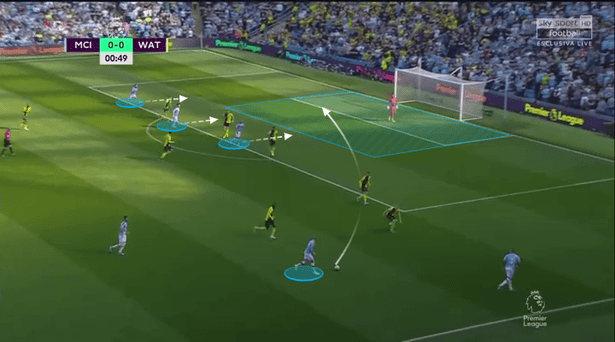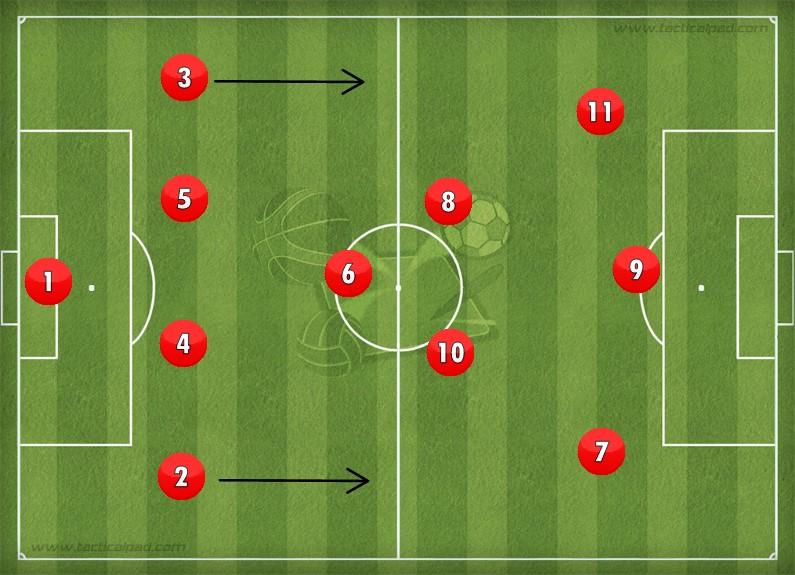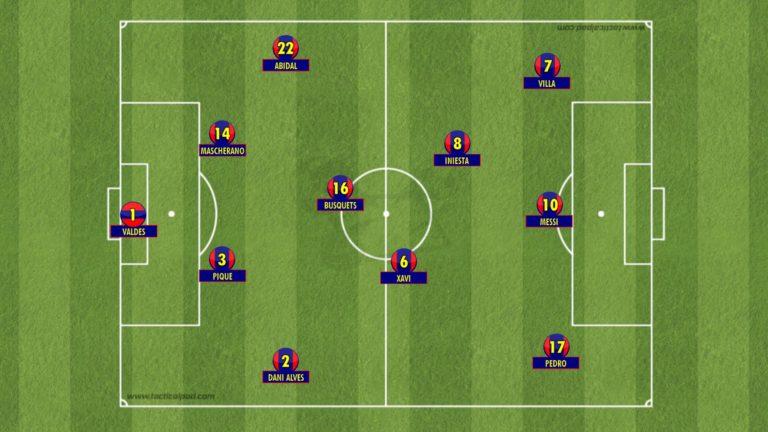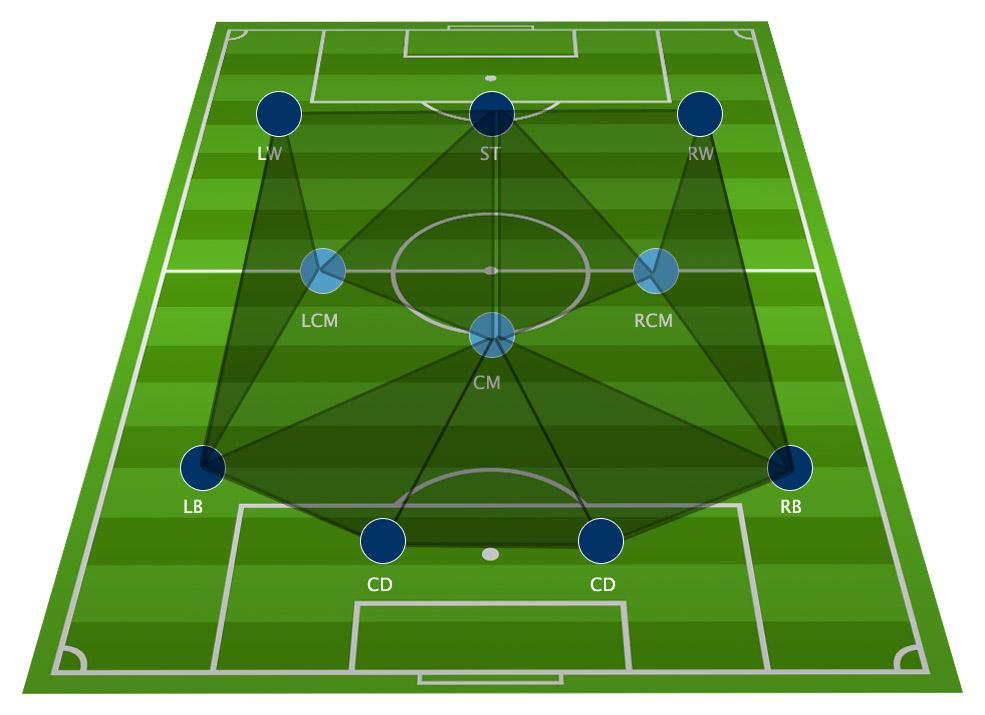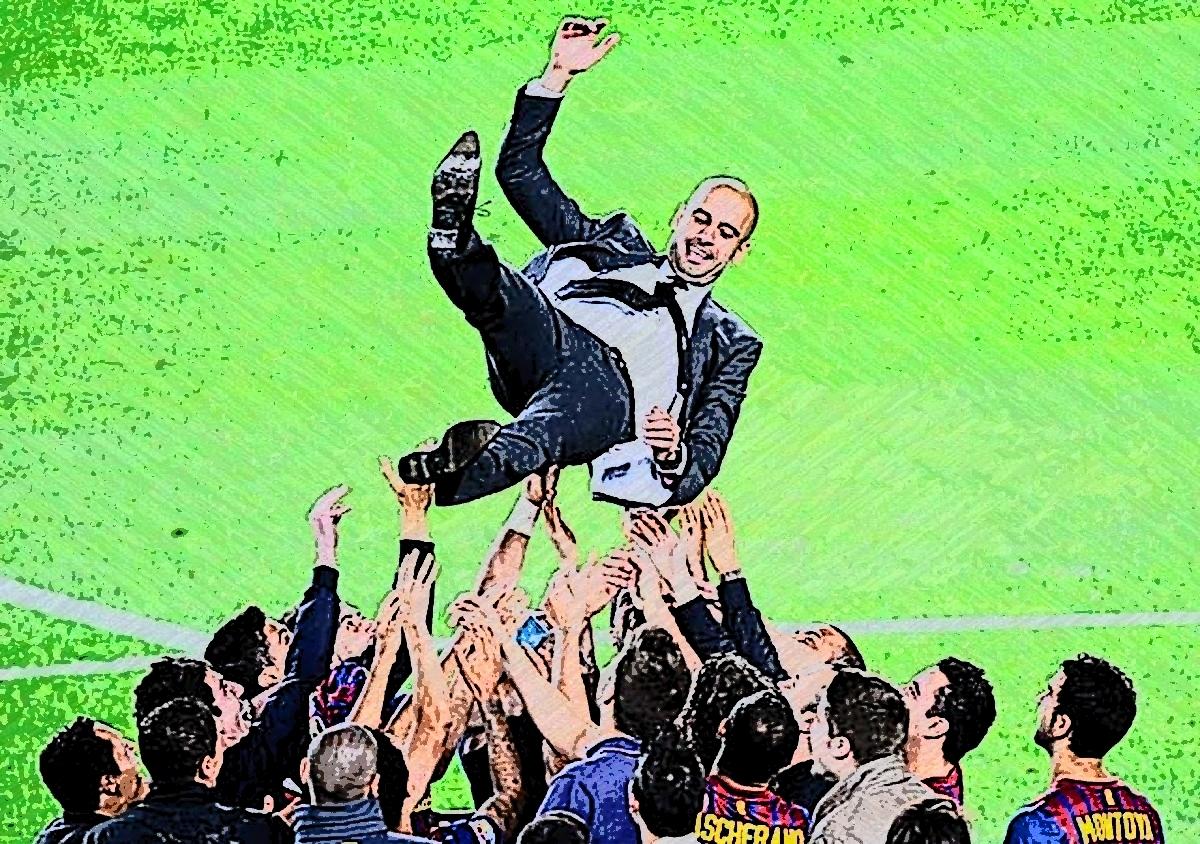
How I Learned to Stop Worrying & Love 4-3-3
It seems that midway through the life-cycle of every Football Manager game there comes a time for change. It is usually when long-running saves start feeling stale. And a new challenge is needed to keep the game fresh. Sometimes it is a matter of changing up the tactics. The recent major Match Engine update has made me realize that my tactics were not doing what I wanted. We were winning games, but not in the way I wished. So I came to a hard decision. It is never easy to set aside a tactic, or club that you invested time into. So this is the kind of worrying that went through my mind, until I rediscovered the fun of FM20. Instead of recreating historic style or tactic I decided to take up the challenge of what I love most about football, scoring goals. All while fine-tuning my favourite 4-3-3 Formation.
It all Began with a Goal
I love to score goals in Football Manager. But not just any goals. I like to see a variety of goals that result from intricate build up. Not just lucky goals from scrambles caused by set pieces. After my initial attempts at recreating classic Dutch Total Football, I finally settled on 4-3-3 system by drawing some inspiration from one of Cruyff’s students. And this time I do not mean Bielsa. The final 4-3-3 that I’ve settled on should to lead to varied goals from different players. By applying concepts of Guardiola’s Positional Play, the overloads generated will create space for your players to exploit in interesting ways. You will see quick cutback goals, worldly long shots from midfield, and real “fox in the box” beauties.
The “fox in the box” poacher is one of my favourite roles in football. Legendary Serie A players like Inzaghi, Batistuta and Shevchenko, stood larger than life due to their goals-scoring exploits. These fantasistas especially impressed on this young Ukrainian boy watching football in late 90s. To this day nothing reminds me of Serie A’s Golden 1990s Era as its absolute fascination with the pure goal-scoring strikers. The poacher acted as the perfect posterboy for the beautiful game, stripping it down to its absolute essence. At its most basic, football is about outscoring your opponent. Even if it’s only by one goal. And scoring goals is not easy, although players like Fiorentina’s “Batigol” Batistuta made it look easy.
In Football Manager, as in real life scoring lots of goals is not a simple thing. It’s the reason why plug-and-play tactics and tactic guides exist. FM enthusiasts will always look for ways to “break” the game and set virtual goal-scoring records. Without going into tactical exploit territory, I tried my own hand at trying to define that magic formula for a goal-scorer in FM19. Since switching to FM20, scoring lots of goals has not gotten any easier. Or so many of the users on the popular Sports Interactive forums claim. In this article I would like to simplify the elements which I believe are essential to scoring goals within one of my favourite formations, 4-3-3. As I believe in FM20 it can be a real goal-machine formation.
Recipe for Success
Now I am going to take the less popular view and say that scoring goals is easy in FM20. Provided you know what you are doing. All it takes is having a clear plan and knowing your players. When you fit a player into his ideal role then you are half way to making a successful tactic. The other half comes from the tactic you play him in.
Firstly, your players and their attributes and traits will tell you who your goalscorers are and who will be the creators. In any successful tactic you will need at least two consistent sources of goals. The rest will need to focus on either support or defence. Initially attribute analysis will help you filter your attackers. Once you have a likely group, you will need to narrow it down further by carefully studying their attributes. The ones with the most well defined key attributes is what you are looking for. While well-rounded attackers are useful, they won’t be your 20+ goals per season goal-machines. The best goal-scorers do not necessarily need to be central strikers. But like a typical poacher, they need to be exceptionally good in at least one thing.
I always look for players with very high values in Off the Ball, Acceleration, and Dribbling coupled with strong mentals. They usually tend to be my best scorers. Players like Fiorentina’s Federico Chiesa or Arsenal’s Nicolas Pépé. Of course, the better their mentals are (especially Composure) the better they will be in front of the goal. But this hopefully will give you an idea of who to look for.
Cogs in The Machine
The second part of scoring goals, is knowing what kind of tactical system will get the best from your players. The saying that the whole is greater than the sum of its parts has never been more true. In football a collection of individual stars will never win anything. While a well-oiled machine of a team will almost always overachieve despite its individual limitations. Sticking with a well-honed balanced tactic will always overachieve more than an overly aggressive one. This has never been more evident than with Guardiola’s Positional Play philosophy. At its height, it not only allowed Barcelona to win two Champions Leagues but helped Messi break world records. In 2012 under Guardiola, he scored 91 goals beating the previous record held by Gerd Müller (85 in 1972). Yet Leo played as a False9 support striker, while Müller was one of the deadliest poachers of his time.
From Center to Wing – Changing Striker Paradigm
“I like the ball, I love the ball. To score a goal you need the ball. So as much as you have it and your percentage is higher, you have more chances to score.” – Pep Guardiola
Messi has always been the exception to the rule. If it hadn’t been him spearheading Guardiola’s Barca then Villa probably would have been the goal-machine of the 2012 campaign. Villa was one of the best strikers in Spanish history. But due to his speed and exquisite technical skills, Pep could play him wide. From the left flank, he would perform curved runs to the penalty box and finish attacks. He was exactly the kind of player that best exploited the overload that Guardiola would create on the opposite wing.
The rise of a wide forward as the team’s primary goal-scorer reflected modern football’s increasing importance of midfield control. This control is generally won through aggressive pressing and Tiki-Taka-style short passing. Something that most average teams just cannot keep up with on a pure technical level. Top teams like Barcelona, and Man City play in the way that puts a lot of emphasis on winning games through winning the midfield battle. This led to dramatic decrease in free space for traditional central strikers to exploit in the middle of the field.
On the other hand, the inside forward has prospered in the Europe’s top five leagues. In recent years it has not been typical central strikers that score most goals at top flight. But it’s inside forwards like Raheem Sterling, Mohamed Salah and Kylian Mbappé who dominate record charts. And it is a trend that has been going on for a while. Just look at the most prolific attacking partnerships in the last decade. Great pairing s such as Lewandowski and Thomas Muller, or Benzema-Ronaldo at Real Madrid.
Similar to Villa-Messi partnership above, Ronaldo and Benzema had almost perfect chemistry during their years together at Madrid. Benzema, operating centrally as a False9, used his teamwork, tactical intelligence, and attacking movement to draw opponents out of position. This created spaces for Ronaldo to make dangerous attacking runs into the center of the area from the left wing,
4-3-3 and Guardiola’s Progressive Possession Style
Now I am going to go ahead and repeat what I already said before. In my opinion, the 4-3-3 is the most versatile and balanced shape in FM20. And probably in football in general. It is due to the fact that 4-3-3 (and its 4-1-4-1 DM variant) unlike the 4-4-2, values the inside forward. In its embrace of the inside forward it is very much a forward-thinking modern formation. With the advent of modern tactics that favour heavy pressing and possession, the middle of the field becomes overcrowded. The only open space that can still be found is often on the wings. It’s where inside forwards can take advantage of their superior speed and dribbling unlike the less mobile traditional Number9 strikers. At the same time, quick and creative False9 like Messi can have great chemistry with inside forwards.
In attack, 4-3-3 can offer both dangerous width and plenty of chances for overloads with the right roles. And most importantly with the correct balance of roles, defence can easily cover for the forwards’ adventurous attacking movement. It is surprising how defensively solid it can be even with as many as 5 players going into attack.
Therefore it is no surprise that 4-3-3 has been favoured by some of the most attack-oriented managers. Both Pep Guardiola in his Positional Play philosophy and Maurizio Sarri (Sarriball) played with some type of 4-3-3. Both are also staunch practitioners of Vertical Tiki-Taka, or progressive possession style. And if you are a top team and not playing progressive possession, then you are doing something wrong. Progressive Possession is possession with an attacking intent. It is not possession for the sake of possession that the classic Tiki-Taka has erroneously become known for. Progressive Possession is key to Guardiola’s Positional Play.
Guardiola never cared about possession alone. Pep is unique among football managers, is that he is not just looking to win but to win in style. In his case, it is Progressive Possession style. Possession numbers in themselves are not important to him. What is important to Guardiola is keeping the ball long enough to enforce his vision of football on the game. Pep’s vision of a perfect game is that of the constantly forward-moving attack. In this the other side has no choice but to play by his rules. And what are these rules you might ask? Read on.
Taking Control of the Half-Space
At Manchester City, Pep has revolutionized the traditional role of the #10 advanced playmaker. He made it a hybrid of the #10 and central midfield runner #8. Pep’s two hybrid 8/10s David Silva and De Bruyne start in midfield but then as the ball is gained, move up to occupy half-space positions, just below the striker. While Silva holds back more to act as a traditional playmaker, De Bruyne uses his physicality to drive forward and link-up with attackers at the edge of the penalty area.
With the two wide attackers stretching the opposition defence on the wings and the False9, Sergio Aguero, dropping deep centrally, Man City’s deadly 5-Pronged Attack is formed. You can see it in action in the image below. There De Bruyne is moments away from delivering a pin-point cross to Aguero. The False9 can then make the decision to shoot on goal or quickly pass to one of the wingers. As the ball shifts opponent’s attention to Aguero, the wingers find themselves with plenty of open space. They can cut in unopposed towards goal and shoot.
This beautiful play of quick passes and one-twos is only made possible through the occupation of the half-spaces. When the midfield is congested with players moving into half-space channels, there is bound to be a lot of space created on the wings. There we have quick wingers to take advantage of the 1v1s created.
Overloads, Cutbacks and Runners
Guardiola always instructs at least one wide players to stay on the far-side from the overloaded side. At Barcelona he used players such as Thierry Henry, Villa, and Alexis Sanchez to generate cutbacks. The width generated in this way, created space for the midfield diamond of the likes of Messi and Iniesta. Many wrongly accuse Guardiola’s Barcelona of seeking possession for the sake of possession. They could not be further from the truth. Guardiola uses midfield ball possession as a way to attract the opposition there. This in turn overloads the center and frees the two wingers. They can then get isolated against their respective fullback in, usually favourable for the winger, 1v1. At its core this simple concept is the central tenant of Positional Play and key to Pep’s success. Simply, overload and isolate.
Origins of Positional Play
Guardiola’s Positional Play or Juego de Posición is the tactical philosophy behind three of his most successful clubs. He first developed it at Barca, where he won everything he possibly could. His next Bayern stint was as impressive, even without Champions League glory. Finally moving to England, allowed Pep a whole new playing field and footballing culture to bend to his will. Arguably he has not reached City’s full potential. But anything is possible now after he spent a few years assembling his perfect team.
At the Camp Nou, Guardiola had The Perfect Team. He knew that his best players were his midfielders, Lionel Messi, Xavi, Iniesta and Busquets. So naturally Guardiola developed a tactical system to get the most of their collective strengths. Thus Juego de Posición was born in Barcelona in 2010. By shifting Leo from his natural attacking midfield position into that of a creative False 9 striker, Pep changed everything. Leo became the crucial centerpin to Pep’s 4-3-3 system just like Cruyff was to Ajax 4-3-3 of 1970s.
Undoubtedly the key was Messi. Pep chose him as the team’s unorthodox central striker. Leo did not fit the typical central striker role of a targetman who holds up the ball and bullies defenders. No, instead he amazed the world with his dribbling and mastery of the ball. Both of which drew opponents to him like flies to raw meat while his teammates were left free to attack. In midfield behind Messi there were the playmaking talents of Xavi and Iniesta. Completing the bottom of this diamond was Sergio Busquets who with his positioning and passing linked the midfield with defence.
The Perfect Team, Perfect Roles
So to summarize, in order to play by Guardiola’s Rules of Positional Play, you will need:
- Control the Half-Spaces (or channels if you will)
- Overload the midfield through numerical superiority
- Use inverted wingbacks to help in the midfield control and overload
- At the same time free up space on at least one flank and have your most dangerous attackers exploit it.
- Keep the ball as much as possible and if you lose it win it back immediately. Thus high defensive line and aggressive pressing are needed.
- Start attacks from the back, getting the centrebacks involved in the buildup.
These should give you the rough idea on the team instructions that we will need. The next part is making sure that each player performs a specific role on the field. Again, like cogs in the machine. You will need a perfect player for each role. By this I do not mean the absolutely best, world-class player. But one that is perfectly suited to play that role due to his key attribute distribution. I will go into more detail on this in the next article where I will present the final tactic. For now these are the player roles you will need. I am using the legendary 2010-2011 Barcelona team as an example of the basic archetypes.
- Valdes was the classic sweeper keeper. His role was essential when playing with a high defensive line. He also acted as an extra player to help in maintaining possession and building attacks up from the back.
- Piqué and Mascherano were the ball-playing central defenders who were comfortable carrying the ball closer to midfielders or fullbacks to gain better passing angles. They were also mobile enough to drop back and cover. So you typical slow and strong defender who can only hoof the ball cannot apply.
- Alves – was the complete wingback with freedom to roam forward. Especially when both Xavi and Iniesta joined the attack. At the same time Abidal was his more conservative partner on the left. He acted like a third centerback at times. Thus defensive balance was kept.
- Busquets – Pivot – the only real specialist role in the whole formation. He was the all-important defensive midfield pivot. Busquets fit into Barcelona’s system perfectly and was the key defensive foil to Messi’s free “Cruyff” role. His timely interceptions coupled with exquisite composure and positioning contributed greatly to maintaining possession and shielding the defence.
- Xavi – Controller– also an important role in the midfield. He was basically a classic #10 who dictated the team’s tempo. He was also key in recycling possession towards areas that opened up after the opposition would overload his side of the field. It helped greatly that he was always able to control the ball even in the face of the most intense opposition pressure.
- Iniesta – Needle Player – who will thread the whole between your midfield and opponent’s defence. As a #8 Iniesta acted like an attacking midfielder who carried the ball forward into dangerous areas. In this he was helped by his unrivaled dribbling skill and low stature (and centre of gravity).
- Pedro – was the versatile winger who hugged the touchline and provided width on the side Guardiola wished to overload. It also allowed Alves cut inside from his fullback position. Sometimes he would cut inside to support Messi and leave room for overlapping Alves on the wing.
- Villa – Shadow Striker – would also stay wide on the left, seemingly harmless as the second winger. But the moment that there was an overload created on the right, his more dangerous side would emerge. Then he would drift inside in a difficult-to-mark curved run toward the penalty box. His reputation for finishing attacks made him into one the best strikers in Spanish history.
- Messi- “Cruyff” Role – Catalyst. Those who read my previous article on Total Football, are probably familiar with Cruyff’s all-important role to Dutch 4-3-3. Best player on the team and the brain of the formation. Guardiola gave him the full freedom to drop deep, drift to the wings or just roam around. The opposition defenders had no choice but follow him. By his mere movement, Leo created space for his teammates. What a real False9 must be.

Again these roles are not meant to be exact replication of 2010 Barca but rather an inspiration for my Total Football 4-3-3 Tactic’s Roles. It’s more of a general amalgam of styles from three of Guardiola-led clubs. For instance, while Alves did a lot of roaming, he did not really act like an inverted wingback. Guardiola did not start using inverted wingback until his Bayern days. What all his tactics between 2010 and 2020 have in common is that 4-3-3 shape (4-1-4-1DM wide if you will). As well as his constant drive to create overloads. That is something that he learned from his great mentors, Cruyff and Bielsa. And is also something that I myself too cannot stop doing. Once you seeing Total Football everywhere, it is hard to go back to playing football any other way.
Hopefully you enjoyed this rough overview to Guardiola-style 4-3-3. It also happened to be Dutch Total Football formation of 1970s. The formation that brought a lot of success to both Ajax and Dutch National Team. It was eventually brought to Spain and Barcelona by Johan Cruyff, where it was learned by Pep Guardiola. Thus it has been refined over two generations. Currently it is a very versatile shape that can bring the best out of your attackers. And help you score lots of goals of course. It is not every formation that provides passing triangles everywhere. And no other shape is easier for keeping possession with short passes. Hopefully I will be able to prove this in the future entries in this 4-3-3-inspired series. Until then happy testing and thank you for reading! And feel free to follow us @ Dictate The Game’s Facebook and Dictate The Game’s Twitter!
NEXT ARTICLE: I will be following in the steps of Bielsa and Guardiola, as I revive Dutch 4-3-3 one Role at a time. Also, I’ll have a Royal time unveiling the club for this challenge.
Tactic In-Progress Download: https://ufile.io/y5tcz3wn









